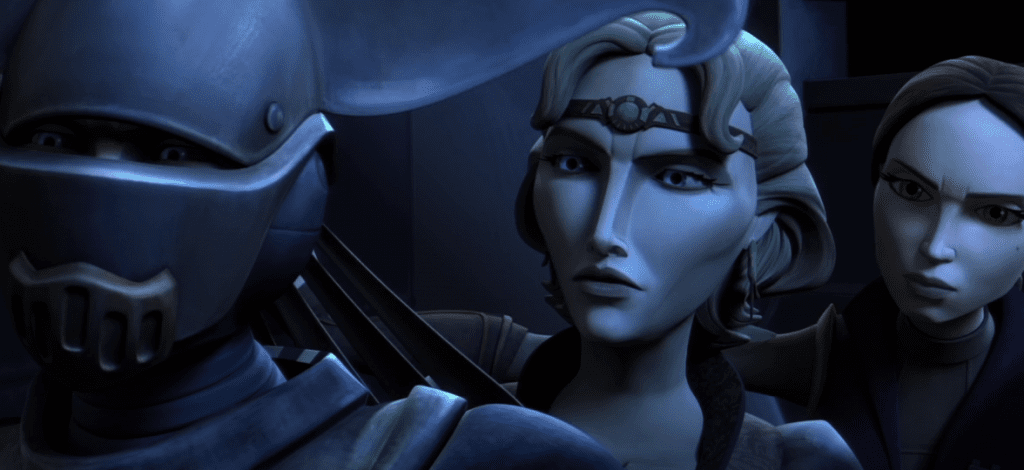Summary
An inconsistent season with a wonky first half and an incredibly strong second, The Clone Wars Season 3 represents the show at its very best and almost worst.
Even by the usual standards of a show where teenage aliens battle with humming multi-colored laser swords, Star Wars: The Clone Wars Season 3 is odd. On the one hand, it’s much more ambitious than its two preceding seasons and much more content to ease off on the action in favor of, for instance, ruminations on trade blockades.
On the other hand, it’s disjointed and strangely paced, and it crams together too many episodes that are too similar. On the third hand (I’m deformed), it introduced Savage Opress. So, what is to be done?
It’ll come as no surprise, but I’m partial to the odd political negotiation, so those elements never bothered me, even when Jar Jar Binks returned (briefly) like some goggle-eyed harbinger of ruin.
I’m likewise fond of the tricky morality found in episodes like “Heroes on Both Sides”, in which wide-eyed and idealistic Ahsoka met some kind-hearted Separatists and began to re-examine her perceptions of right and wrong – welcome territory in a show that, since its first season, has dealt primarily on absolutes. As I’m sure you know, this is a very Sith thing to do.
I’m a big believer in the value of continuity, so I enjoyed the two-part opening story, which returned to the Clone Troopers we met in the standout Season 1 episode, “Rookies”, and which included an attack on Kamino’s training facility by General Grievous and Asajj Ventress, who I was happy to see again.
And while we’re on the subject of villains, Aurra Sing made a fine one in “Assassin”, where she repeatedly attempted to assassinate Padme only to be repeatedly thwarted by Ahsoka and the senator herself. Someone ought to inform all the Clone Wars-era villains that Ms. Amidala is essentially immune to contract killings; she’s so smooth and soft, and quite unlike sand, that she always slips away unharmed.
What I don’t like, though, and what I will never like, is episodes occurring out of sequence for no properly justified reason. The Clone Wars Season 3 has enough issues with bunching clumps of its character-specific episodes together. The last thing it needs is for those episodes to flit up and down the timeline like the writers are playing a guitar solo on the neck of Star Wars continuity. Several episodes were set before Ziro the Hutt was liberated from prison by Cad Bane, and that occurred way back in Season 1.
There is never any need for such fancy-pants mystery-box structuring, least of all in a Star Wars show pitched primarily at children. (Even though we established in the second season that children exposed to The Clone Wars would likely become serial killers.)

(Credit: Disney)
Luckily, the back half of the season made up for the silliness with one great episode after another; the strongest stretch of The Clone Wars thus far, by quite a margin in my humble (and correct) opinion. The introduction and crafting of Savage Opress as a formidable new villain was only part of it.
All those episodes lent a necessary focus on the villains of The Clone Wars Season 3, including Ventress and Count Dooku, the latter of whom had several moments of peerless badassery that weren’t possible in live-action, given that Christopher Lee was 287 years old when Episode II: Attack of the Clones was filmed.
The best episode of The Clone Wars Season 3 was “Witches of the Mist,” which contains a three-way lightsaber duel that is easily one of the best in the entire Star Wars canon. Inexplicably, I haven’t mentioned this until now, but since its inception, The Clone Wars has provided a bunch of fine action sequences, including many lightsaber duels, but none quite like this, partly because it involved two characters whose fates haven’t been predetermined by existing materials.
That having been said, some of the best stuff in The Clone Wars Season 3 dealt with well-known characters, like a trilogy of episodes in which Obi-Wan and Anakin are treated to visions of their future by a father, son, and daughter who seemed to be physical manifestations of the Force itself.
Wilhuff Tarkin turns up for a couple of episodes that are referenced in James Luceno’s canon novel, and there was even room for Chewbacca, who debuted in a typically kid-friendly pair of finale episodes that knocked-off Predator as Ahsoka was captured and hunted for sport.
But despite the second half firing on all cylinders, The Clone Wars Season 3 is let down by its haphazard opening to such an extent that one can hardly call it a distinct improvement over the solid second season.
Its highs are higher, but it’s also burdened by that slapdash, unnecessarily convoluted structure, and as fond as I might be of politicians falling victim to poisoned tea, it’s hard to think back to those early episodes without wondering how much better they might have been if Savage Opress had been doing the serving.
Read More:



